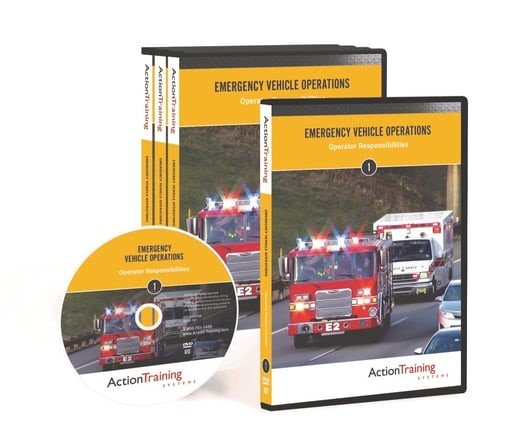 Image 1 of 1
Image 1 of 1


Emergency Vehicle Operations: 4-Part DVD
The priority for all emergency vehicle operators (EVOs) is to ensure the safety of themselves and crew, their patients, and the public. Having the skills and competency behind the wheel is critical to their success. Every department should have a comprehensive driver training program in place. This series is designed to enhance your training curriculum and to provide EVOs with foundational knowledge or a review of the information and skills required according to the NFPA, IAFC and NAEMT.
Titles Include:
1. Operator Responsibilities
Describes a driver’s responsibilities to their crew and patients. Reviews laws and regulations that pertain to emergency vehicle operations. Presents different vehicle characteristics and technology. Discusses use of warning devices, predetermine response routes and modes of driving. Best practices for restraints use, securing patients and airbag safety are also reviewed.
2. Driving Skills & Techniques
Describes the driving skills and techniques required for EVO, how the physical forces in driving affect vehicle operations such as stopping distances, and weight transfer. Guidelines for driving in adverse road conditions, including the use of brakes and preventing skids are reviewed. Demonstrations include basic driving skills and maneuvers used in emergency vehicle operations.
3. Operator Response Guidelines
Describes best practices for defensive driving, evasive maneuvers and stopping distance factors. Presentation includes intersection safety, navigating controlled and uncontrolled intersections, and traffic preemption systems. Reviewed are best practices en route to an emergency, such as adhering to speed limits, creating safety cushion, turning and passing guidelines, and the use of privately owned vehicles. Incident positioning and roadway safety is also demonstrated.
4. Vehicle Inspection & Maintenance
Describes best practices for emergency vehicle maintenance, including the use of checklists and the importance of record keeping. Demonstrations include inspections of exterior and interior of the vehicle, the engine compartment, and electrical systems. Brake testing and road performance tests are also demonstrated.
Development Standards & Guidelines include:
NFPA 1010, NFPA 1500, NFPA 1550
IAFC Guide to Model Policies & Procedures for Emergency Vehicle Safety, 2010.
NAEMT Guidelines for EVO, Joint Statement, 2/14/22.
USFA Emergency Vehicle Safety Initiative, 2015.
The priority for all emergency vehicle operators (EVOs) is to ensure the safety of themselves and crew, their patients, and the public. Having the skills and competency behind the wheel is critical to their success. Every department should have a comprehensive driver training program in place. This series is designed to enhance your training curriculum and to provide EVOs with foundational knowledge or a review of the information and skills required according to the NFPA, IAFC and NAEMT.
Titles Include:
1. Operator Responsibilities
Describes a driver’s responsibilities to their crew and patients. Reviews laws and regulations that pertain to emergency vehicle operations. Presents different vehicle characteristics and technology. Discusses use of warning devices, predetermine response routes and modes of driving. Best practices for restraints use, securing patients and airbag safety are also reviewed.
2. Driving Skills & Techniques
Describes the driving skills and techniques required for EVO, how the physical forces in driving affect vehicle operations such as stopping distances, and weight transfer. Guidelines for driving in adverse road conditions, including the use of brakes and preventing skids are reviewed. Demonstrations include basic driving skills and maneuvers used in emergency vehicle operations.
3. Operator Response Guidelines
Describes best practices for defensive driving, evasive maneuvers and stopping distance factors. Presentation includes intersection safety, navigating controlled and uncontrolled intersections, and traffic preemption systems. Reviewed are best practices en route to an emergency, such as adhering to speed limits, creating safety cushion, turning and passing guidelines, and the use of privately owned vehicles. Incident positioning and roadway safety is also demonstrated.
4. Vehicle Inspection & Maintenance
Describes best practices for emergency vehicle maintenance, including the use of checklists and the importance of record keeping. Demonstrations include inspections of exterior and interior of the vehicle, the engine compartment, and electrical systems. Brake testing and road performance tests are also demonstrated.
Development Standards & Guidelines include:
NFPA 1010, NFPA 1500, NFPA 1550
IAFC Guide to Model Policies & Procedures for Emergency Vehicle Safety, 2010.
NAEMT Guidelines for EVO, Joint Statement, 2/14/22.
USFA Emergency Vehicle Safety Initiative, 2015.

